Why settle for the real thing when you can get the miniature version? Herein lies the appeal of puppies, tiny electronic items and bonsai trees.
The art of bonsai traces its origins back to Tang dynasty China, where penjing (盆景), literally "tray landscape," developed from an imperial delight to a popular art form. According to legend, the idea of miniature trees goes back even further to a Han emperor who had a miniature version of his empire, complete with mini trees, created in his courtyard so that he could gaze over his "domain" from his window.
Miniature trees found their way to Japan, where they became "bonsai" ("tray-planted"), during the large-scale Chinese culture importation of the Heian period (794 AD to 1191). Long reserved for the elite, bonsai didn't gain mass popularity until the 14th century.
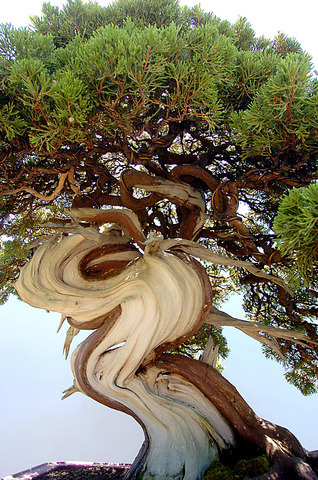
PHOTOS: LO PEI-DER, TAIPEI TIMES
As early as the 16th century, traders and missionaries brought bonsai from Japan and China back to Europe. By the late 1800s, two Japanese nurseries had set up shop in New York. Soldiers returning from Japan after World War II with bonsai trees fueled the growing popularity, and many Western nurseries began to grow bonsai. Today, prize-winning bonsai are cultivated from Thailand to Puerto Rico, England and the US.
In Taiwan, bonsai culture began in the late Qing dynasty. Taiwan's oldest living bonsai is a 240-year-old banyan that resides in Tainan's Kaiyuan Monastery (
"If you count bonsai growers registered with an association, there are between 10,000 and 20,000. For unregistered growers, the number is more like 100,000," said Yen Zi-jing (顏子景), who owns Bonsai World in Beitou (北投).
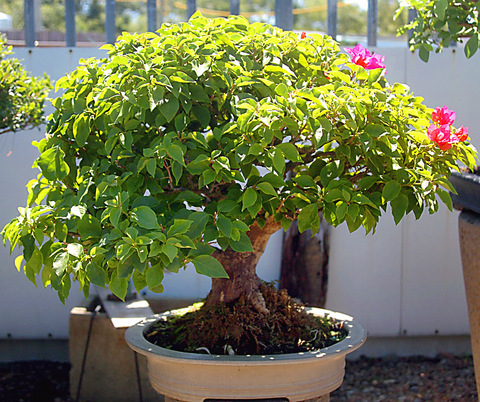
Bonsai growers in Taiwan are luckier than most: they have the climate on their side. The subtropical temperatures allow the trees to grow faster for longer. According to Yen, that means a fully developed tree can be produced in Taiwan in half the time it takes in Japan, where the climate is temperate.
Meanwhile, Taiwan's mountains mimic temperate and even frigid climates, providing for a broad range of tree species. These factors combine to make Taiwan's bonsai second only to Japan, said Yen.
Depending on its target size, a bonsai begins as a cutting or a seedling. Over the course of about five years it is pruned periodically to develop tapered trunks and branches. Young seedlings will naturally keep an even thickness for several meters. With bonsai, the trunk is chopped off at progressively higher points, causing it to grow thinner and thinner towards the top, creating the gnarled, tapered look of an old tree. The same is done to the branches.
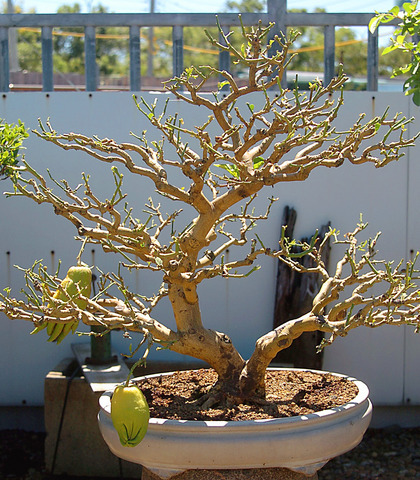
The most basic principle of bonsai is that every part of the miniature tree -- roots, trunk, branches and leaves -- should be in proportion.
Not all species of tree are suitable for bonsai cultivation. The tree has to have naturally small leaves or be able to
develop them, and the space between leaves must be minimal. This can also be done with careful pruning -- the less space between leaves, the smaller they will grow.
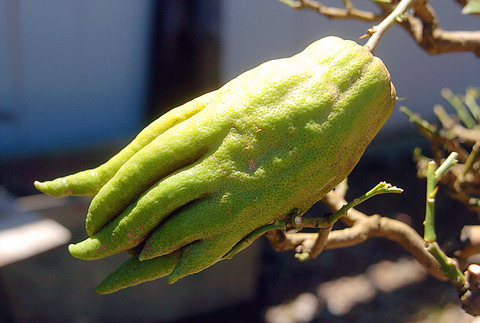
Trees that are popular in Taiwan include tamarind, Chinese parasol trees, common jasmine orange, Formosa firethorn, maple, Chinese hackberry and even guava, but the most widely grown is the banyan.
"Taiwan's banyan bonsai are the best in the world," Yen said. "But as for exports, the cypress is our top tree." Evergreens are especially valued in the bonsai tradition due to their sturdiness. Cypress, which grows with a bent trunk in nature, is consi-dered the most beautiful tree to grow as a bonsai.
"One of the important issues for bonsai creation is how to catch the specific characteristic and spirit of each species. Cypress is grown at high altitudes ... Affected by the violent geography and climate, it always develops a flexible trunk and branches ... Tender but tough, cypress fully reveals the value of life and accommodation in adverse circumstances," writes Yunlin (
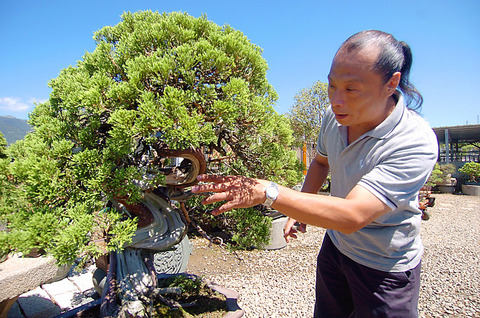
According to Yen most of the value of a bonsai depends on its age and how well it imitates nature. Yet to the trained eye, a beautiful bonsai is one that goes beyond simple realism to convey a deeper, indescribable aesthetic.
Yen, who offers classes in the art of bonsai, emphasized the importance of learning how to appreciate that aesthetic before spending a large sum on a banyan tree. The trees in his nursery -- mostly large bonsai that are 40 to 50 years old -- cost from NT$150,000 to NT$3,000,000. For those with a tighter budget and a less discerning eye, a smaller, younger bonsai from the Jianguo Weekend Flower Market (
Bonsai World is at 235, Chengde Rd, Sec. 5, Beitou, Taipei.
The Web site is www.bonsai.org.tw/aiabonsai/
The phone number is (02) 2828 8022.

It is a soulful folk song, filled with feeling and history: A love-stricken young man tells God about his hopes and dreams of happiness. Generations of Uighurs, the Turkic ethnic minority in China’s Xinjiang region, have played it at parties and weddings. But today, if they download it, play it or share it online, they risk ending up in prison. Besh pede, a popular Uighur folk ballad, is among dozens of Uighur-language songs that have been deemed “problematic” by Xinjiang authorities, according to a recording of a meeting held by police and other local officials in the historic city of Kashgar in

The Directorate-General of Budget, Accounting and Statistics (DGBAS) told legislators last week that because the Chinese Nationalist Party (KMT) and Taiwan People’s Party (TPP) are continuing to block next year’s budget from passing, the nation could lose 1.5 percent of its GDP growth next year. According to the DGBAS report, officials presented to the legislature, the 2026 budget proposal includes NT$299.2 billion in funding for new projects and funding increases for various government functions. This funding only becomes available when the legislature approves it. The DGBAS estimates that every NT$10 billion in government money not spent shaves 0.05 percent off
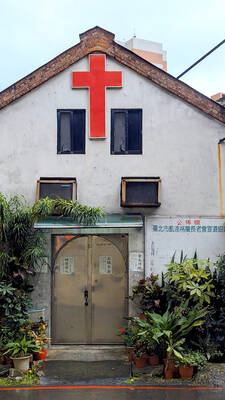
Dec. 29 to Jan. 4 Like the Taoist Baode Temple (保德宮) featured in last week’s column, there’s little at first glance to suggest that Taipei’s Independence Presbyterian Church in Xinbeitou (自立長老會新北投教會) has Indigenous roots. One hint is a small sign on the facade reading “Ketagalan Presbyterian Mission Association” — Ketagalan being an collective term for the Pingpu (plains Indigenous) groups who once inhabited much of northern Taiwan. Inside, a display on the back wall introduces the congregation’s founder Pan Shui-tu (潘水土), a member of the Pingpu settlement of Kipatauw, and provides information about the Ketagalan and their early involvement with Christianity. Most

The People’s Republic of China (PRC) was out in force in the Taiwan Strait this week, threatening Taiwan with live-fire exercises, aircraft incursions and tedious claims to ownership. The reaction to the PRC’s blockade and decapitation strike exercises offer numerous lessons, if only we are willing to be taught. Reading the commentary on PRC behavior is like reading Bible interpretation across a range of Christian denominations: the text is recast to mean what the interpreter wants it to mean. Many PRC believers contended that the drills, obviously scheduled in advance, were aimed at the recent arms offer to Taiwan by the